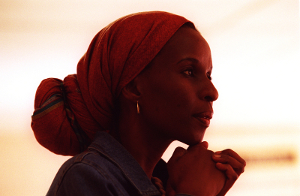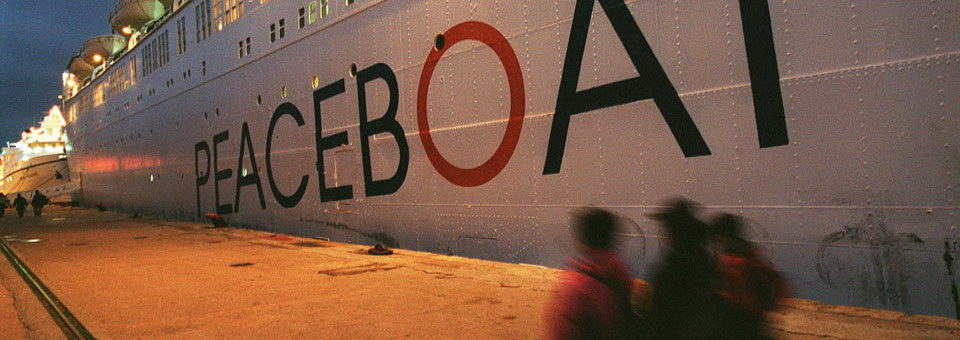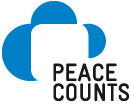South Africa: Jailhouse Rock
 Text based on reportage by Uschi Entenmann
Text based on reportage by Uschi Entenmann
Photos: Uli Reinhardt
The tough guys wait. They sit in silence on a long wooden bench, two dozen thieves and murderers. Their heads are shaved. Their coveralls are fire-engine red. Across each man’s chest is emblazoned the word “Prisoner,” along with a name: Ebrahim, Eric, Moses.
A foreboding stillness dominates the dust-gray room as the men take stock of Victoria Maloka, an attractive black woman in tight jeans and a bat-winged blouse. “I’m from the Center for Conflict Resolution,” she explains. “We want to help you to solve your problems without busting each other’s heads.” She looks from prisoner to prisoner, laughing. “That means you respect each other and value the human dignity of everybody around you.”
Human dignity? No one says a word. Victoria is used to that. Every mediator in the Center for Conflict Resolution (CCR) in Cape Town knows it takes time and patience to reach the prisoners. South Africa, ten years after the end of apartheid, is rife with tension. CCR attempts to solve some of those conflicts with long-term programs. Its trainers work systematically with schools and teachers as well as with police, prisoners, and prison guards. Its mediators advise high-ranking officers, including defense and foreign ministers, in Malawi, Burundi, Somalia, Zimbabwe, and Sudan. But still, one of their most difficult hurdles is only two hours north of Cape Town by car, behind the walls of Vorberg Prison.
Indistinct noise echoes through the barred windows, a medley of voices, footsteps, and yelling from 1,600 prisoners who live more than 20 to a cell. Every evening when the steel gates close, the gangs take over. They offer their members protection and are known by numbers. “26” is for thieves, “27” for homosexuals. The oldest, most powerful gang is that of the murderers, “28.” The name commemorates a revolt staged by 28 prisoners in Pullsmore Prison, nearly 100 years ago. The “numbers” are organized militarily. Their generals and “blood officers” incite gang warfare with weapons made from toothbrushes and smuggled razor blades. Under the prison’s flat roof, they decide who will live and who will die.
Mogamat Benjamin, from cell 191, was once a blood officer in 28. He can’t remember how many men he has killed. But he explain readily how newcomers are treated. The “birds” becomes slaves, carrying messages, scrubbing cells. In exchange they are raped and beaten. “We kill them if we have to, to show them we’re the 28, and they should show us respect.” After a bloody ceremony that concludes the trial period, a survivor can live in relative safety as a member of a number – as long as he follows the rules.
One man who managed to break the cycle of violence and revenge is Thomas Ngolobe. “I’d like to change,” he admits. “But if I go outside without protection from the numbers, I’d be dead. How can I change if I’m here and my head is over there somewhere?” Prisoners stab each other, kill guards, guards kill prisoners. “Human dignity” in Vorberg is an empty phrase from a foreign language.
Victoria Maloka isn’t afraid to enter the ring. “You get more from talking to each other than from striking each other,” she tells their stony faces. “So we’ll start by having each one of you tell me, is there a person in the world that you really like, someone you can really trust?” Her gaze goes down the row. She nods encouragement, but the men are uncomfortable talking about their feelings. After a while a tall, solid black man, almost a giant, confesses that he is fond of his mother. His declaration breaks the spell. Opening one’s soul to this attractive woman apparently has its benefits. Most all the men like their mothers and are willing to say so. One names his wife, another, his little daughter.
After the ice is broken, Maloka leads the first exercise, a sort of dance. She claps a rhythm and asks the men to follow her example, one at a time. The first adds a flourish. The second matches it. The third stands up, stretches out his arms, and sways to the rhythm. In the end the whole group is on its feet, swinging its hips, bumping into each other, getting out of breath. The jailhouse rocks. “How do you feel?” Maloka calls out. Danood, a lifer tattooed up to his ears, gets a laugh as he tap-dances across the floor and cries, “I feel free!”
It’s a good start for the next exercise, which brings the notions of respect and dignity into play in a surprising way. She commands the men to form four groups, “Quick!” When the groups have formed in the corners of the room, she gives each group a balloon. “The balloon symbolizes your dignity. It’s valuable. Think about how you can defend it from the other groups!” The men consult with each other. Veronica gives them a little time, then says, “It’s the moment of truth. You have two minutes to let out your aggression. Now go!”
Nothing happens at first. The groups watch each other warily. Then two men leave their clan and go on the attack. They break through a row of defenders. The balloon pops. Suddenly the room is filled with aggression and chaos. One balloon after another is heard to break, even the one a prisoner is holding toward the ceiling while sitting on another prisoner’s shoulders. The horde pulls him down. Whoever has no balloon left to defend joins the attack. Chairs fall, a table tips over, men are on the floor and on their feet again in an instant, but the balloons are gone.
“Did you notice?” Victoria Maloka asks in the stillness that descends. “At first everybody was quiet. As soon as one of you started being destructive, it was chaos.” The men are grinning. She looks around the group. “Do you ever think about why you’re here?” she adds. “You all like your mothers. Did they want you to end up here?” A brief word of conclusion: “Conflicts are inevitable.” The men are already on their way to the exit. “Even more so in prison. But you can learn how to solve them in a halfway peaceful kind of way.”
This playful mental training in respect and dignity will go on for a long time. Week after week, she will ask the men to dance and role-play, but more than anything, she will encourage them to talk to each other. She is aware of the risk that one might attack her if he feels provoked. Most of them have nothing to lose. But she is a success. Her employer, the CCR, has a good record. It has been sending peacemakers into the prisons for five years, and the murder rate has sunk significantly.
It’s an amazing process. The mediators, as the course leaders call themselves, deal with unrepentant criminals. “They have grown up in a world ruled by the law of the jungle. They haven’t been to school. They’re unemployable,” Maloka explains. “The only social bond they have in prison is the gang. It’s like a family. In these surroundings, it’s essential for survival.”
Maloka, 32, has two children. She knows what an important role social bonds can play. She comes from farm country, 60 miles north of Pretoria. Her home village has had a telephone for three months now, but still has no electricity. But despite poverty and isolation, life there was good. Her father played the role of village patriarch – mayor, judge, and mediator. Petitioners, plaintiffs, defendants took turns knocking on their door. Her father was constantly busy healing neighborhood rifts, deciding what punishment was appropriate for a chicken thief, or promoting the expansion of the school. “With this job, I’m walking in his footsteps,” says Maloka.
The University of Cape Town founded the Center for Intergroup Studies in 1968. Its mission was to make peace between the country’s many factions. Although apartheid was abolished in 1994, the conflicts remained. Renamed the Center for Conflict Resolution, the institution employs 40 mediators and trainers. There are more requests for help than the center can fulfill.
Monday morning at nine in Bertram House, a registered historic site on the campus of the University of Cape Town. Through the panoramic windows Table Mountain dominates the view, under a bright, clean sky. Laurie Nathan, 44, director of the CCR, has just returned from Zimbabwe. He has spent four days talking with delegates of the two large political parties. At the weekly staff meeting, he raves about his morning jogs past Victoria Falls. “Fantastic!” Unfortunately, that was his trip’s only positive outcome. South Africa’s neighbor has an inflation rate of 500% and 70% unemployment. Hunger affects 5.5 million people, and 4,000 die every week from AIDS. President Robert Mugabe is under pressure. His party and the opposition negotiate listlessly at regular intervals about forming a coalition government. Laurie Nathan was invited in as a consultant.
Nathan is white and upper class. He spent his first 18 years “in a white cocoon” in Cape Town, encountering black people only as household help. At the university he met black students and activists who could “climb up on a podium and put clear visions into words.” A year after graduating, he traveled to Munich and visited the concentration camp site in Dachau. “On the way back I thought, you know, that’s what’s happening in my country.” He became a conscientious objector, joined an opposition group, and spent two years in hiding. “I wasn’t too afraid of getting caught. I was young and enthusiastic.” A bitter smile: “Besides, it was only the black activists that got tortured in prison.”
Not much has changed after ten years without apartheid. White privilege remains, “as do the problems facing the black population,” Nathan says. The majority of blacks live in grinding poverty without access to medical care, money, or education. The police are brutal in their reactions to even minor crime, where blacks are involved. “They were oppressed for 300 years,” Nathan says. “You can’t turn that around in just ten.”
But what has been done is a start. When the CCR started work, Laurie Nathan had 11 white colleagues. Now he has 40, mostly black. The annual budget has increased tenfold, largely through donations from national governments including those of Holland, Belgium, Sweden, England, Norway, and Finland. German money comes from the Konrad Adenauer and Friedrich Ebert Foundations, which sponsor individual workshops.
The Monday morning discussion with instant coffee and red bush tea is short and succinct. Attorney Kholosile Mazaza reports of a first meeting in Hout Bay, an upscale coastal section of Cape Town. Next to it, thousands of the poor have settled in impromptu shacks. The town council demands that the eyesore vanish and asks the CCR to mediate. Next agenda item: Mediator Alison Lazarus has visited three refugee camps in Burundi where conditions are so drastic that conflict is inevitable. She wants to found a women’s self-help group and train it in mediation. Pepe Hendrick, psychologist and actor, has spent the weekend at Red Cross headquarters trying to iron out a tug-of-war between various contenders for the office of chairman. Michelle Parlevliet has visited a murder-plagued penitentiary in Malawi, where 70 prisoners now share a cell. Nqaba Nonga has taken on the delicate task of mediating between two gang bosses engaged in a bloody territorial feud in a Cape Town township. The discussion is like a tour of southern Africa, with all its conflicts and contradictions.
The success of CCR can be traced in part to its training of people accustomed to transcending conflict as ambassadors to carry its message. Ndileka Ngomo is such a person. With her shaggy hair, chubby cheeks, and easy, open laugh, she is a dead ringer for Whoopi Goldberg. She teaches in the elementary school in Langa, one of many township shantytowns that insult the general loveliness with huts of corrugated sheet metal and cardboard. CCR has just organized a three-day workshop in which 13-year-old slum-dwellers met their cohorts from the elegant suburb of Camps Bay. “On the first day they were still afraid of each other,” says Ngomo with her Whoopi-grin. “A lot of white children have never met a black who wasn’t working for them.” They returned impressed from their field trip to the black school, where 70 children are crammed into each classroom. The next day, the students visited tony Camps Bay. White, rich, and immaculate meets black, poor, and shabby – the contrasts virtually forced the children to talk. Their fears vanished. “By the second day, there was a party atmosphere,” says Ngomo. After a pause, she adds, “Of course life is easier if you’re born rich. But black kids can be honest, even if they live in Manenberg.”
Manenberg is the urban worst-case scenario. The bleak neighborhood is home to 90,000 people and 20 gangs. Their names sound harmless: Playboys, Justice, Dixie Boys. But their wars over drugs, weapons, and power are anything but. Police provide little more than a counterweight. Trained in gang warfare, they patrol the townships every night armed to the teeth. Nighttime is synonymous with war.
“The police hunt killers. But even killers have dignity. That’s what these guys have to learn,” says Victoria Maloka, pulling on her black boots. “The police is brutal even when it’s superfluous.” The CCR has been working with the police for ten years, trying to demonstrate through workshops and role-playing that violence is not the best way to solve conflicts. “Violence provokes and creates more violence,” Maloka knows – not from book-learning, but from what she sees every day.
Today she will accompany a police commando unit on a manhunt. She is as popular at the station as she is in the prison. “Hello, heroes!” she calls out as the men surround her. Kevin, built like a refrigerator, helps her gallantly into her bulletproof vest and is rewarded with a brilliant smile. Emergency call: everyone jumps into police cruisers to speed to an attempted murder. They reach the turnoff for Petrics Lane and stop dead. “Too narrow,” Kevin bellows. They will be forced to storm the crime scene on foot. “This is pretty dangerous, even for us,” he growls. “There are three gangs running this place.” Down the street children yell and raise their hands high, the ring and middle fingers bent down. “That’s the Hard Living Gang sign. Even the little kids want you to know they belong. This rat hole produces the most powerful gangs.”
The driver, Davis, edges the car against the curb. The doors slam open and the four officers sprint to a high-rise apartment building. They duck through open windows, slither past rotting wooden doors, give iron fire-escapes a brief visual scan. The place is swarming with people – drunks, junkies, dealers, and children everywhere you look. The men storm into an apartment where children sit in front of the TV with the recipient of the gunfire. Who was it? Supposedly a neighbor, but which one? Maybe somebody from across the street in house 14. And why? He doesn’t know. The policemen are in a rage. Gerome is about ready to apply “prudent and necessary force” to the wounded man. “Maybe we should try asking the people in house 14,” Victoria Maloka suggests. They try it. An old woman opens the door. She hisses that her son is not at home, slamming the door.
Another case at midnight is more successful. In a back courtyard they collar the 18-year-old Francisco. They’ve had their eyes on him for a while. “A killer!” they say. The information comes from the secret police. Wedged in between Gerome and Kevin, he sits in the back seat of the police care. They shove him back and forth, screaming questions into his impassive face. “He’s high as a kite,” Kevin curses. But only he knows where to find the dealers who provide the gangs with weapons. “Talk!” Gerome commands him. Francisco murmurs an address while Davies steers the car towards the station. Francisco is led to a cell. “They’ll know you ratted,” says Kevin. “If we put you back out on the street, you won’t last long.”
The end of another exciting shift, or a night like any other – Victoria Maloka drives home to her children, whom she will soon wake up and take to school. Then she’ll prepare for a strategy meeting with female colleagues on the theme of human rights and conflict management. While she mixes up an instant coffee and sets the breakfast table for her children, she scribbles a few words on the back of her hand. They are key words she wants to mention when calling potential sponsors later on. Like all project employees, she has to finance her programs herself.
Kevin, too, drives home. He lives with his family in Manenberg. Doesn’t he fear for his children and grandchildren? He shakes his head. “We have the guys upstairs,” he grins, pointing to the starry sky over the Cape of Good Hope. “All four of us are religious. A Catholic, an evangelical, a Moslem, a Methodist. Believer cops. Nothing bad can happen to us. All the Gods are watching.”

